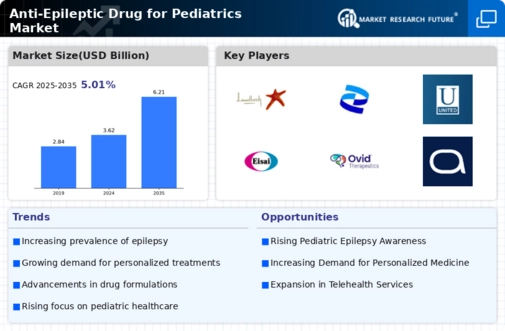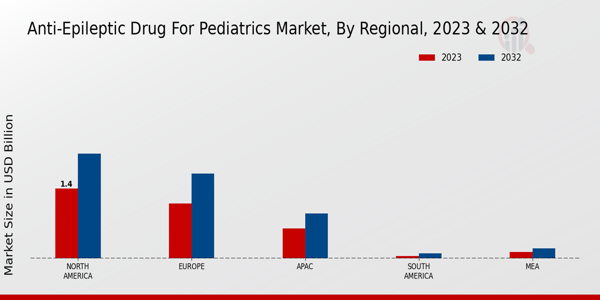Market Growth Projections
The Global Anti-Epileptic Drug for Pediatrics Market Industry is projected to experience substantial growth over the next decade. With a market value of 3.62 USD Billion in 2024, it is anticipated to reach 6.21 USD Billion by 2035, reflecting a robust CAGR of 5.02% from 2025 to 2035. This growth trajectory is indicative of the increasing demand for effective anti-epileptic medications for children, driven by factors such as rising prevalence of epilepsy, advancements in drug development, and enhanced awareness among healthcare providers and patients.
Advancements in Drug Development
Innovations in pharmacological research and drug formulation are significantly influencing the Global Anti-Epileptic Drug for Pediatrics Market Industry. The development of new anti-epileptic medications, including those with improved efficacy and safety profiles, is likely to enhance treatment options for pediatric patients. For instance, the introduction of novel compounds that target specific seizure types could lead to better management of epilepsy in children. As a result, the market is projected to grow at a CAGR of 5.02% from 2025 to 2035, ultimately reaching an estimated value of 6.21 USD Billion by 2035.
Increased Awareness and Education
There is a growing emphasis on raising awareness and educating both healthcare professionals and the public about epilepsy, which is a crucial driver for the Global Anti-Epileptic Drug for Pediatrics Market Industry. Campaigns aimed at improving understanding of epilepsy symptoms and treatment options are likely to lead to earlier diagnosis and intervention. This increased awareness may result in a higher demand for anti-epileptic medications, as more children receive timely treatment. Consequently, this trend could contribute to the anticipated growth of the market, aligning with the overall increase in pediatric epilepsy cases.
Government Initiatives and Funding
Government initiatives aimed at improving healthcare access for children with epilepsy play a significant role in driving the Global Anti-Epileptic Drug for Pediatrics Market Industry. Various countries are implementing policies to enhance the availability of anti-epileptic drugs and support research in this area. For example, funding for epilepsy research and treatment programs can lead to the development of new therapies and improved access to existing medications. Such initiatives are likely to bolster market growth, as they create a more favorable environment for the introduction and distribution of anti-epileptic drugs.
Growing Adoption of Personalized Medicine
The shift towards personalized medicine in the treatment of epilepsy is emerging as a key driver for the Global Anti-Epileptic Drug for Pediatrics Market Industry. Tailoring treatment plans based on individual patient profiles, including genetic factors and specific seizure types, may enhance therapeutic outcomes. This approach is gaining traction among healthcare providers, as it allows for more effective management of epilepsy in children. The increasing focus on personalized treatment strategies is expected to contribute to market growth, as it aligns with the broader trend of individualized healthcare.
Rising Prevalence of Epilepsy in Pediatrics
The increasing incidence of epilepsy among the pediatric population is a primary driver for the Global Anti-Epileptic Drug for Pediatrics Market Industry. Recent statistics indicate that approximately 1 in 100 children are diagnosed with epilepsy, necessitating effective treatment options. This growing prevalence is expected to contribute to the market's expansion, with projections suggesting that the market will reach 3.62 USD Billion in 2024. As awareness of epilepsy increases, healthcare providers are more likely to prescribe anti-epileptic drugs, thereby driving demand in this sector.
























